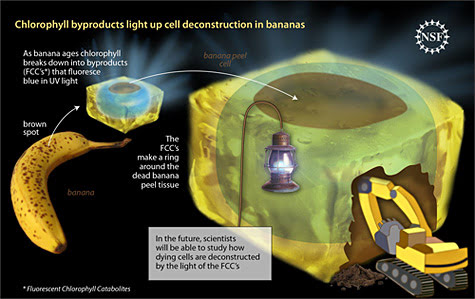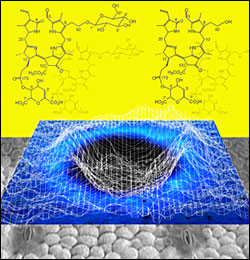
Blue Bananas Linked to Cell Death
INNSBRUCK, Austria, & NEW YORK, Sept. 10, 2009 – Bright blue luminescent rings found under UV light on the peels of very ripe bananas hold promise for studying how organisms rid themselves of dying cells, according to chemists in the US and Austria.

|
As bananas age, the chlorophyll in their peels breaks down into particles called FCCs (fluorescent chlorophyll catabolites). Since these glowing particles occur in close proximity to dying tissue, they could enable the study of programmed cell death. (Image: Zina Deretsky, National Science Foundation)
|
Nicholas Turro of Columbia University in New York, Bernhard Krautler of the Institute of Organic Chemistry at the University of Innsbruck, Austria, and their colleagues found that, as chlorophyll ages and begins to disintegrate in banana peels, it releases particles called fluorescent chlorophyll catabolites, which glow blue under UV light.

Ripening bananas glow blue in UV light, which also reveals halos around the dying tissue of the dark spots. On the left is a photograph of a banana using “white” daylight. On the right is a photo showing the banana in “black” light. (Image: Simone Moser, University of Innsbruck, Austria, et al.)
Chlorophyll is the molecule that makes much of life on Earth possible. It allows plants to take in a mixture of carbon dioxide, water and sunlight and convert it to oxygen, sugars and starches. The breakdown of chlorophyll is a major contributor to the color changes in autumn leaves and in ripening apples and pears. But in ripening and rotting bananas, chlorophyll’s catabolites, or breakdown products, are unique in that they are fluorescent, causing yellow bananas to glow blue under UV light, said the chemists in a paper, published online Sept. 8, in the Proceedings of the National Academy of Sciences (PNAS).

Light-blue glowing rings surround the dying cells on the skin of a ripe banana. The fluorescent by-products of chlorophyll as it breaks down make it possible for the first time to visualize a plant's aging process. Credit: University of Innsbruck)
While the blue light serves to attract a host of potential consumers, such as insects and other animals that can see UV light, the fact that ripe bananas luminesce in the ultraviolet spectral range is equally exciting to chemists. Because the glowing molecules occur in close proximity to dying tissue, they may be a literal beacon for the study of programmed cell death – the way organisms cleanse themselves of dying cells. A well-recognized but poorly understood condition in which programmed cell death malfunctions is cancer.
“This work brings to fruition some of the remarkable principles of fundamental organic photochemistry harvested from more than four decades of professor Turro’s research at Columbia,” said George Kenyon, program officer in the National Science Foundation’s chemistry division.
For more information, visit: www.nsf.gov/news
Published: September 2009